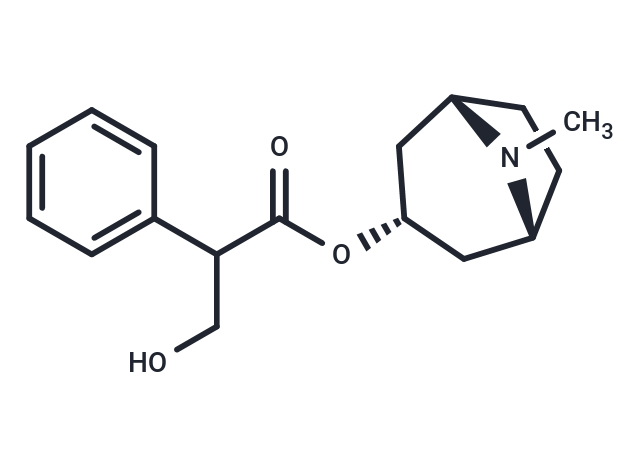Shopping Cart
- Remove All
 Your shopping cart is currently empty
Your shopping cart is currently empty

Atropine (DL-Hyoscyamine) Sulfate is the sulfate salt of atropine, a naturally-occurring alkaloid isolated from the plant Atropa belladonna. Atropine functions as a sympathetic, competitive antagonist of muscarinic cholinergic receptors, thereby abolishing the effects of parasympathetic stimulation.


| Description | Atropine (DL-Hyoscyamine) Sulfate is the sulfate salt of atropine, a naturally-occurring alkaloid isolated from the plant Atropa belladonna. Atropine functions as a sympathetic, competitive antagonist of muscarinic cholinergic receptors, thereby abolishing the effects of parasympathetic stimulation. |
| Kinase Assay | Biochemical Tyrosine Kinase Assays: IC50 values for Sunitinib against VEGFR2 (Flk-1) and PDGFRβ are determined using glutathione S-transferase fusion proteins containing the complete cytoplasmic domain of the RTK. Biochemical tyrosine kinase assays to quantitate the trans-phosphorylation activity of VEGFR2 (Flk-1) and PDGFRβ are performed in 96-well microtiter plates precoated (20 μg/well in PBS; incubated overnight at 4 °C) with the peptide substrate poly-Glu,Tyr (4:1). Excess protein binding sites are blocked with the addition of 1-5% (w/v) BSA in PBS. Purified GST-fusion proteins are produced in baculovirus-infected insect cells. GST-VEGFR2 and GST-PDGFRβ are then added to the microtiter wells in 2 × concentration kinase dilution buffer consisting of 100 mM HEPES, 50 mM NaCl, 40 μM NaVO4, and 0.02% (w/v) BSA. The final enzyme concentration for GST-VEGFR2 or GST-PDGFRβ is 50 ng/mL. Twenty-five μL of diluted Sunitinib are subsequently added to each reaction well to produce a range of inhibitor concentrations appropriate for each enzyme. The kinase reaction is initiated by the addition of different concentrations of ATP in a solution of MnCl2 so that the final ATP concentrations spanned the Km for the enzyme, and the final concentration of MnCl2 is 10 mM. The plates are incubated for 5-15 minutes at room temperature before stopping the reaction with the addition of EDTA. The plates are then washed three times with TBST. Rabbit polyclonal antiphosphotyrosine antisera are added to the wells at a 1:10,000 dilution in TBST containing 0.5% (w/v) BSA, 0.025% (w/v) nonfat dry milk, and 100 μM NaVO4 and incubated for 1 hour at 37 °C. The plates are then washed three times with TBST, followed by the addition of goat antirabbit antisera conjugated with horseradish peroxidase (1:10,000 dilution in TBST). The plates are incubated for 1 hour at 37 °C and then washed three times with TBST.The amount of phosphotyrosine in each well is quantitated after the addition of 2,2′-azino-di-[3-ethylbenzthiazoline sulfonate] as substrate. |
| Alias | Tropine tropate, DL-Hyoscyamine |
| Molecular Weight | 289.37 |
| Formula | C17H23NO3 |
| Cas No. | 51-55-8 |
| Smiles | O=C(C(c1ccccc1)CO)O[C@H]1C[C@H]2CC[C@H](N2C)C1 |
| Relative Density. | 1.19 g/cm3 |
| Storage | Powder: -20°C for 3 years | In solvent: -80°C for 1 year | Shipping with blue ice. | ||||||||||||||||||||||||||||||||||||||||
| Solubility Information | DMSO: 96.6 mg/mL (333.83 mM), Sonication is recommended. H2O: 2.9 mg/mL (10.02 mM), Sonication and heating are recommended. | ||||||||||||||||||||||||||||||||||||||||
Solution Preparation Table | |||||||||||||||||||||||||||||||||||||||||
H2O/DMSO
DMSO
| |||||||||||||||||||||||||||||||||||||||||

Copyright © 2015-2025 TargetMol Chemicals Inc. All Rights Reserved.